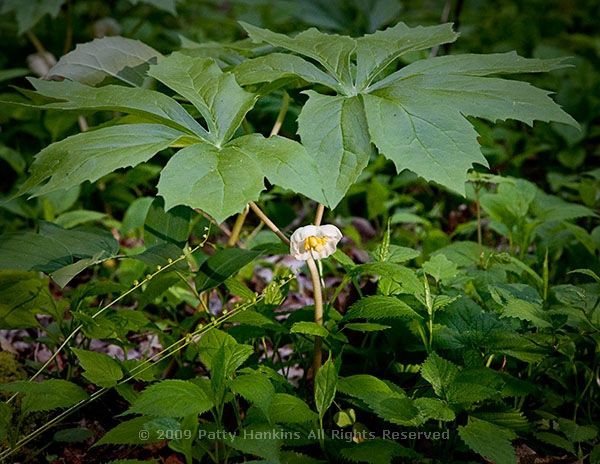(c) 2010 Patty Hankins
One of the very common spring wildflowers in the Eastern United States is May Apple (Podophyllum peltatum). I’ve seen and photographed the May Apples in several states – and I still keep an eye out for them. The white flower hidden under the large leaves can be so pretty in the early spring.
(c) 2009 Patty Hankins
May Apples are native from the East Coast to as far west as Texas and Minnesota. They are also found in Nova Scotia, Quebec and Ontario in Canada. Only in Florida are they listed as endangered. A member of the Berberidaceae or bayberry family, May Apples are also known as the American or wild Mandrake.
(c) 2009 Patty Hankins
May Apples are easy to see in the woods. They have two large leaves – with a single white flower growing at the axil of the leaves. The plants grow to about two feet tall, and the leaves are six to eight inches across. The flowers have between six and nine white petals – with yellow stamens in the center. If you see a May Apple with only one leaf – it won’t have a flower. They only flower when they have two leaves.
(c) 2010 Patty Hankins
The flowers of the May Apple bloom in the spring. I’ve seen them in April in Tennessee and as late as June in Pennsylvania. In the summer, a greenish yellow berry also grows beneath the leaves.
(c) 2010 Patty Hankins
May Apples have been used medicinally in the past. The roots were used by Native Americans as a cathartic. The fruit can be used in jellies. The leaves, roots and seeds of the May Apple are poisonous and can kill if ingested in large quantities. It’s best just not to comsume any part of the May Apple.
(c) 2010 Patty Hankins
All of my May Apple photos were taken in National Parks in Tennessee. My photos of the May Apples from 2009 were taken along the Ash Hopper Trail in the Great Smokey Mountains National Park. The 2010 photos were taken along the Little Kiddie Trail in the Chickamauga and Chattanooga National Military Park.
For more information about May Apples, the following sites have additional information
Native American EthnoBotany Database
Lady Bird Johnson Wildflower Center





